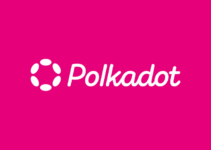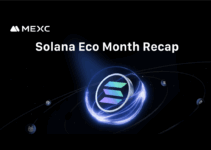
In the ever-evolving world of cryptocurrency, stability can be hard to find. While Bitcoin and Ethereum capture headlines with their price volatility, stablecoins like USDC (USD Coin) offer a different approach by combining blockchain technology with the stability of traditional currency.
This comprehensive guide will explore everything you need to know about USDC—from its creation and backing to how it’s used in today’s digital economy. You’ll learn how USDC works, how it compares to other stablecoins like Tether (USDT), which blockchain networks support it, and practical ways to use, buy, and store this digital dollar. Whether you’re looking to protect your crypto investments from market volatility, make fast cross-border payments, or earn yield through decentralized finance, this article will provide you with the knowledge to confidently navigate the world of USDC and stablecoins.
Key Takeaways
- USDC is a digital stablecoin pegged 1:1 to the US dollar, combining blockchain efficiency with price stability
- Each USDC is backed by actual US dollars and short-term Treasury bonds, with reserves verified through regular third-party audits
- Created in 2018 by the Centre Consortium (Circle and Coinbase) to enable faster, more accessible global transactions
- USDC offers advantages over USDT (Tether) in terms of transparency and regulatory compliance
- Available on 19 blockchain networks including Ethereum, Solana, and Polygon, offering flexibility for different use cases
- Primary uses include protection against crypto market volatility, low-cost global transfers, and earning yield through DeFi platforms
- MEXC provides multiple ways to buy USDC including spot trading, credit/debit cards, and P2P transactions
- Despite strong safety measures, users should be aware of potential risks related to bank stability and smart contract vulnerabilities
Table of Contents
Understanding USDC (USD Coin)
What is USDC?
USDC (USD Coin) is a digital stablecoin that is pegged to the U.S. dollar on a 1:1 basis. Unlike typical cryptocurrencies and altcoins that fluctuate in value, USDC is designed to maintain a stable price equivalent to one U.S. dollar. Each USDC token in circulation is backed by one U.S. dollar held in reserve, along with short-term U.S. Treasury bonds, ensuring its stable value.
USDC is often described as “digital money for the digital age,” bridging traditional finance with the speed, efficiency, and accessibility of blockchain technology. As a regulated stablecoin, USDC provides a reliable way to hold, send, and receive value in the cryptocurrency ecosystem without worrying about price volatility.
Who Created USDC? The Story Behind USDC
USDC was first announced in May 2018 and officially launched in September 2018. It was created by the Centre Consortium, a joint venture formed by Circle, a peer-to-peer payment services company, and Coinbase, one of the largest cryptocurrency exchanges. The founders, including Circle co-founders Jeremy Allaire and Sean Neville, aimed to create an open network for global value exchange, similar to how the internet enabled open information sharing.
Since its launch, USDC has grown to become one of the largest stablecoins in the world, with billions of dollars in circulation across multiple blockchain networks.
How Does USDC Work?
The Minting and Burning Process
Unlike cryptocurrencies such as Bitcoin that are released through mining, USDC works through a process called minting and burning. When a user or business deposits U.S. dollars into their Circle account, Circle issues (or “mints”) an equivalent amount of USDC tokens. These tokens are then sent to the user’s digital wallet.
Conversely, when someone wants to redeem their USDC for U.S. dollars, they send the tokens back to Circle, which then “burns” (destroys) these tokens and returns the equivalent amount in U.S. dollars to the user. This process ensures that the number of USDC tokens in circulation always matches the amount of U.S. dollars held in reserve.
Is USDC Backed By USD? Reserve Assets Backing USDC
What makes USDC trustworthy is its transparent reserve system. Every USDC token is backed by highly liquid cash and cash-equivalent assets. According to Circle, the majority of USDC reserves are invested in the Circle Reserve Fund, an SEC-registered government money market fund managed by BlackRock.
The reserve consists of cash held in segregated accounts at U.S.-regulated financial institutions and short-term U.S. Treasury bonds. This approach ensures that USDC maintains its 1:1 peg with the U.S. dollar and can be redeemed at any time.
Transparency and Regular Audits
To maintain trust, Circle publishes monthly attestation reports from independent accounting firms. These reports verify that the amount of U.S. dollars held in reserve matches the number of USDC tokens in circulation. Initially, Grant Thornton LLP served as Circle’s independent auditor from 2015, and since 2022, Deloitte & Touche LLP has taken over this role.
Daily, independent, third-party reporting on the portfolio that supports USDC is publicly available via BlackRock, offering unprecedented transparency compared to many other financial instruments.

USDC vs. Other Stablecoins
USDC vs USDT, Is USDC Better Than USDT?
In the stablecoin market, USDC and USDT (Tether) are the two leading players. While both aim to maintain a 1:1 peg with the U.S. dollar, there are important differences between them:
- Transparency: USDC provides monthly attestation reports and real-time reporting of its reserves, while USDT has faced criticism for lack of transparency.
- Regulatory Compliance: USDC’s reserves are held with regulated financial institutions and follow strict regulatory standards. USDT has faced regulatory scrutiny, including a $41 million fine in 2021 for misleading users about its reserves.
- Market Capitalization: USDT has a larger market capitalization, but USDC has been growing steadily and has captured significant market share.
- Transaction Volume: Despite a smaller market cap, USDC has higher transaction volumes, especially in the United States and among institutional investors.
Advantages of USDC
USDC offers several advantages that have contributed to its growing popularity:
- Regulatory Compliance: Circle is registered as a Money Services Business with FinCEN and holds licenses in multiple jurisdictions globally.
- Transparency: Regular attestations and daily reporting provide users with confidence in USDC’s backing.
- Multi-Chain Support: USDC is available on more than 15 blockchain networks, making it highly accessible.
- Integration with DeFi: USDC has become a cornerstone of decentralized finance applications.
- Speed and Cost: USDC transactions settle quickly and with low fees compared to traditional financial systems.

Blockchain Networks Supporting USDC
Major Blockchains Where USDC is Available
USDC is natively supported on 19 blockchain networks, including:
- Ethereum: The original blockchain where USDC was launched as an ERC-20 token
- Solana: Known for high-speed, low-cost transactions
- Polygon: A layer-2 scaling solution for Ethereum
- Avalanche: A platform for launching decentralized applications
- Algorand: A blockchain focusing on security and scalability
- Base: A newer Ethereum layer-2 solution
- Arbitrum: An Ethereum scaling solution using optimistic rollups
- Stellar: A network designed for financial inclusion
- NEAR: A blockchain with sharding technology
- Noble: A blockchain connected to the Cosmos ecosystem
This multi-chain approach allows users to choose the network that best suits their needs in terms of speed, cost, and functionality.
Native vs. Bridged USDC
There are two types of USDC that can exist on blockchain networks:
- Native USDC: Directly issued by Circle on specific blockchains. Native USDC is fully backed by Circle’s reserves and can be redeemed 1:1 for U.S. dollars.
- Bridged USDC: Created when USDC is locked on one blockchain and a synthetic version is minted on another through third-party bridge applications. Bridged USDC (sometimes called USDC.e) is not issued by Circle and carries additional risks.
It’s important to be aware of which type of USDC you’re interacting with, as only native USDC is fully reserved and designed to be redeemable directly from Circle-authorized partners.
Practical Uses of USDC
Store of Value During Market Volatility
One of the primary uses of USDC is as a safe haven during cryptocurrency market volatility. When prices of Bitcoin, Ethereum, or other cryptocurrencies become unstable, traders often convert their holdings to USDC to preserve value. Since USDC maintains a stable value pegged to the U.S. dollar, it provides protection against market downturns while allowing users to keep their assets in the digital realm, ready to re-enter the market when conditions improve.
Low-Cost Global Transactions
USDC enables fast, low-cost transfers across borders without the delays and high fees associated with traditional banking systems. Traditional international transfers can take days and incur significant fees, especially for smaller amounts. With USDC, users can send money globally in minutes, regardless of the amount, making it ideal for remittances and international business payments.
DeFi Applications and Yield Earning
USDC has become a cornerstone of decentralized finance (DeFi) applications. Users can:
- Earn Yield: Deposit USDC into lending protocols to earn interest rates often higher than traditional savings accounts
- Provide Liquidity: Supply USDC to decentralized exchanges and earn a portion of trading fees
- Borrow Against Collateral: Use USDC as collateral to borrow other cryptocurrencies
- Trade: Use USDC as a trading pair with other cryptocurrencies
These DeFi applications allow users to put their USDC to work, generating passive income while maintaining the stability of a dollar-pegged asset.

How to Buy and Store USDC
Buying USDC on MEXC
MEXC provides several convenient methods to purchase USDC:
- Spot Trading: After creating an account and completing KYC verification, you can buy USDC via spot trading by first adding USDT, USDC, or USDE to your wallet, then navigating to the spot trading page.
- Debit or Credit Card: MEXC allows you to purchase USDC directly using a debit or credit card, offering real-time conversion rates and instant purchases.
- Bank Account: You can link your bank account to MEXC for a simple and secure way to buy USDC directly from your bank, supporting both local and international banks.
- P2P Trading: MEXC’s peer-to-peer platform allows you to buy USDC directly from other users, with flexible payment options and escrow services for security.
- Third-Party Payments: MEXC integrates with third-party payment providers like Banxa, MoonPay, and Mercuryo, making USDC purchases effortless through your preferred payment gateway.
Best USDC Wallet for Storage
After purchasing USDC, you have two main storage options:
- Exchange Wallets: You can store USDC directly on MEXC or other exchange wallets for convenience, especially if you plan to trade frequently. While convenient, this method means trusting the exchange with custody of your assets.
- Self-Custody Wallets: For greater security and control, you can transfer USDC to self-custody wallets:
- Software Wallets: Digital wallets like MetaMask or Phantom that exist as apps or browser extensions
- Hardware Wallets: Physical devices like Ledger or Trezor that store your private keys offline for maximum security
When choosing a wallet, consider factors like security needs, how frequently you’ll access your USDC, and which blockchain network your USDC is on, as different wallets support different networks.
Is USDC Safe?
Reserve Transparency
USDC’s safety is largely based on its transparent reserve system. Circle publishes monthly attestation reports from independent accounting firms that verify the reserves backing USDC. Additionally, the majority of USDC reserves are held in the Circle Reserve Fund, with daily reporting publicly available via BlackRock. This level of transparency is uncommon in financial instruments and provides users with confidence that their USDC is fully backed.
Regulatory Compliance
Circle takes a comprehensive approach to regulatory compliance across multiple jurisdictions:
- United States: Circle operates under state money transmission laws and is regulated as an electronic “stored value” instrument. It’s registered as a Money Services Business with FinCEN and was the first company to receive a BitLicense from the New York State Department of Financial Services.
- Europe: USDC’s issuance in the European Economic Area complies with the Markets in Crypto-Assets (MiCA) regulatory framework. Circle France holds an e-money institution license from the French banking regulatory authority.
- Singapore: Circle operates under the oversight of the Monetary Authority of Singapore with a Major Payment Institution license.
This strong regulatory foundation makes USDC one of the most compliant stablecoins in the market.
Potential Risks
Despite USDC’s strong safety profile, users should be aware of potential risks:
- Bank Stability Risk: In March 2023, USDC temporarily lost its peg when Silicon Valley Bank collapsed, as it held 8% of USDC’s reserves. Though the peg was restored within days, this event highlighted the dependency on traditional financial institutions.
- Regulatory Changes: Future changes in stablecoin regulations could impact USDC’s operations.
- Smart Contract Risk: Like all blockchain-based assets, USDC relies on smart contracts that could potentially have vulnerabilities.
- Bridged USDC Risk: Users should be cautious with bridged forms of USDC (like USDC.e) that aren’t directly issued by Circle and carry additional third-party risks.

Future of USDC
Growth and Adoption Trends
USDC has experienced significant growth since its launch in 2018. While it faced challenges, including the temporary de-pegging incident during the Silicon Valley Bank collapse, recent trends show a recovery in market capitalization and increased adoption. Studies indicate that USDC adoption is growing more rapidly than USDT in some markets, particularly in the United States and among institutional users.
As digital payments continue to evolve, USDC is positioned to play a crucial role in bridging traditional finance with blockchain technology. Its regulatory compliance and transparency make it attractive for institutions entering the cryptocurrency space.
Integration with Traditional Finance
USDC is increasingly integrating with traditional financial systems:
- Payment Networks: Major payment networks like Visa have announced support for USDC settlements.
- Banking Partnerships: BNY Mellon, America’s oldest bank, serves as the primary custodian of assets backing USDC.
- Institutional Adoption: Major financial institutions, including BlackRock, have shown interest in USDC, with BlackRock serving as a primary asset manager for USDC cash reserves.
These partnerships indicate a growing convergence between traditional finance and digital assets, with USDC serving as a bridge between these worlds.
Conclusion
USDC combines dollar stability with blockchain efficiency, offering a reliable gateway to the crypto world without price volatility risks. Whether you’re protecting investments, making global transfers, or exploring DeFi, MEXC provides an ideal platform for your USDC journey with multiple purchase options, competitive fees, and exclusive earning opportunities through spot trading, staking, and promotional events. Ready to experience the benefits of digital dollars? Create your MEXC account today and join thousands of users already leveraging USDC’s potential.
Frequently Asked Questions (FAQ)
When was the first USDC stablecoin issued by Circle?
USDC was first announced in May 2018 and officially launched in September 2018 by the Centre Consortium, which was formed through a joint venture between Circle and Coinbase.
What does USDC stand for?
USDC stands for “USD Coin,” indicating that it’s a cryptocurrency coin pegged to the value of the US dollar.
What is the difference between USDC and USDT?
The main differences between USDC and USDT (Tether) are in transparency and regulatory compliance. USDC provides monthly attestation reports of its reserves and follows strict regulatory standards, while USDT has faced criticism for lack of transparency and regulatory issues. USDC’s reserves are primarily held in cash and short-term US Treasury bonds, while USDT’s backing has been questioned. Despite having a smaller market cap, USDC often has higher transaction volumes, especially in the US.
Is USDC and USDT the same?
No, USDC and USDT are different stablecoins issued by different companies. While both are designed to maintain a 1:1 peg with the US dollar, they differ in terms of issuing company, transparency practices, regulatory compliance, and reserve composition.
What can you do with USDC?
USDC has multiple use cases: storing value during crypto market volatility; making fast, low-cost global transactions; sending cross-border remittances; participating in decentralized finance (DeFi) applications to earn yields; trading against other cryptocurrencies; and serving as a dollar-denominated digital payment method.
How long does USDC take to transfer?
USDC transfer times depend on the blockchain network being used. On Ethereum, transfers typically take 1-5 minutes, while networks like Solana or Avalanche can process transactions in seconds. During periods of high network congestion, transfers may take longer, especially on the Ethereum network.
Where can I buy USDC?
USDC can be purchased on MEXC exchange through several methods, including spot trading, direct purchase with debit/credit cards, bank transfers, P2P trading, or via third-party payment providers. The process typically involves creating an account, completing verification, and then buying USDC through your preferred payment method.
What is USDC on Coinbase?
On Coinbase, USDC is a stablecoin that’s co-founded by Coinbase itself (along with Circle). Coinbase users can buy, sell, send, and receive USDC with zero fees for conversions between USD and USDC. Coinbase also allows users to earn rewards on their USDC holdings in some regions.
Is USDC a good investment?
USDC is not designed to appreciate in value like other cryptocurrencies, as it maintains a stable 1:1 peg with the US dollar. It’s better viewed as a stable store of value or a utility tool rather than an investment for capital gains. However, USDC can be used in various DeFi protocols to earn yield, which some might consider an investment strategy.
Which of the following best describes the use cases of USDC?
The best description of USDC’s use cases would be: a digital dollar that enables stable value storage, efficient global payments, remittances, and participation in decentralized finance applications, all while maintaining the price stability of the US dollar combined with the speed and accessibility of blockchain technology.
What blockchain is USDC on?
USDC is available on 19 blockchain networks, including Ethereum, Solana, Avalanche, Polygon, Arbitrum, Base, Algorand, Stellar, NEAR, Noble, Hedera, zkSync, Optimism, and others. This multi-chain approach increases USDC’s utility and accessibility across the cryptocurrency ecosystem.
How safe is USDC?
USDC is considered one of the safer stablecoins due to its transparent reserve system, regular attestations by independent accounting firms, and strong regulatory compliance. However, like all financial instruments, it carries some risks, including dependency on traditional banking systems (as seen during the Silicon Valley Bank incident), potential regulatory changes, and smart contract vulnerabilities.
Join MEXC and Get up to $10,000 Bonus!
Sign Up


